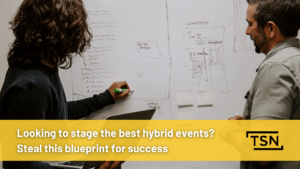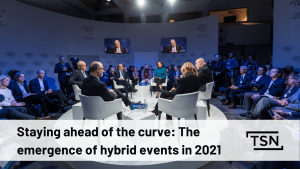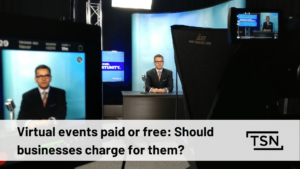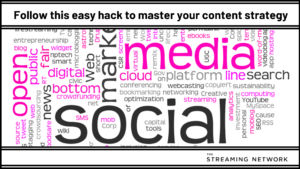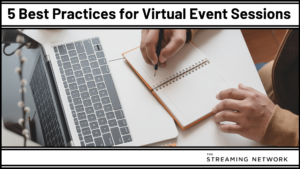Podcast: Play in new window | Download | Embed
Subscribe: Apple Podcasts | Google Podcasts | RSS
Creating a webinar takes a great deal of time, effort, and courage. It’s never a great feeling to see a project fail after investing so much into one.
In the fourth installment of Lessons from the Frontline, we discuss some of the horror stories that can occur when streaming on a large scale and how it informs effective webinar execution.
In Our Fourth Episode We Discuss:
- Streaming For All: Anyone can press a button and stream with today’s technology, but there’s a fine line between doing it well and “just doing it.”
- The Cautionary Tale: Just because something is feasible does not mean it’s a good idea. Measure the complexity against the outcome to project the expected value.
- Mistakes Happen: Mistakes happen and you deal with it, but there will be an impact. It’s not okay for things to go down during a corporate event.
- Preparation: Leaving yourself with enough time and checking your work is crucial before going live. Failing to do so could hurt your credibility and overshadow your message.
The Complete Video Transcript:
Mr. Pete: Matt Ley, welcome back to The Webinar Lessons From the Front Line.s Today’s episode promises to be a fun one, Virtual Event Bloopers, Horror Stories from the Front Lines. You recently blogged about the hashtag epic fail of the live stream of the Mayweather McGregor fight. I’m sure everyone’s heard about it by now, not necessarily about your blog but certainly about the fight. Hopefully, people heard about your blog, hopefully, some people, at least a decent amount of people.
While the rest of us were simply downright frustrated, as a guy who depends on live streaming for your livelihood you saw this glitch as more of a cautionary tale.
Mr. Matt Ley: Yeah, well first and foremost I mean, Dana took to the web and he called out his service provider, a company called NeuLion and they have hosted the UFC for many years.
They’ve hosted the UFC.tv application and in many ways that application or that format has really changed the way that live streaming is delivered for sporting events.
If you’d never gotten a chance to experience it before they got dumped after this fight. You’re picking your own camera angles, you’re creating your own replays. There is a lot of options that simply TV could never do, and in a lot of ways was better than paying for the pay-per-view on television.
So, in this case, I mean I think it’s important for UFC fans to know that Dana did nothing wrong. He contracted and worked with a leading provider in the space.
These guys are not some, it’s not like he cut corners from a cost perspective. I’ve worked with him before on some very large projects and they’re the type to ensure that the steps are taken to ensure success.
Mr. Pete: You were with the –?
Mr. Matt Ley: NeuLion guys. Yeah, I’ve worked with NeuLion before on some of the biggest events we were ever involved in before. Early on streaming was just streaming. No one knew how to do it so whether you were The Streaming Network, or you were NeuLion, or you were anyone when someone had a problem like when bodybuilding.com got rights to the Arnold Classic and the Mr. Olympia they had some issues with live streaming.
They went out and found some experts, they relied on us for a couple of years. We worked with NeuLion from a platform perspective, so I know the way that they work, and I know that they can handle large audiences. This might have been just something unique happened. I don’t know what happened.
It’s like I said in my blog I would have loved to have seen Dana maybe not call them out, a partner who had worked so well with them, but I know that he was facing like a class-action lawsuit and to be clear I have no idea what went wrong.
I think it was the paywall and not the distribution. But in the end, I mean these types of things they can’t happen on any scale, right, not just for the fight of the century but any event that we’re doing, and these are the things that as someone who’s looking to put on a virtual event, whether it be a webinar or some sort of a broadcast of one of the corporate events they need to watch out for.
Mr. Pete: So how do you ensure in your world, that you don’t come across your own epic fail?
Mr. Matt Ley: Well, I think that platform has something to do with it and so and I would say to the buyer if you’re going out and you’re looking to buy, you want to focus some time on platform, on redundancies, on the sheer volume of people that run through the platform on a daily basis. When it comes to webinars in the true sense that we all think about them most platforms are provided by billion-dollar businesses like Cisco, Citrix, Adobe, in our case.
They are large organizations that have tons of customers and for the most part, the products technically work.
Now when you get into the broadcast side where some of us will need to do a virtual event that goes beyond the webinar, that has a live streaming component that is a maybe it’s a product launch from a venue and that sort of thing, now we get players that enter the space that don’t have that type of cachet behind them from a platform because it’s actually — if you Google it and know a little bit of technicals it’s actually quite easy to stream live on the Internet. It’s not easy to do it well, it’s not easy to make sure that it works, but it’s quite easy to do.
Mr. Pete: There is a technology there that would allow you to push a button and be live.
Mr. Matt Ley: Right, without a lot of capital investment and capital outlay. And so when you’re going out and looking you want to make sure that the person you’re dealing with I think in my mind, is the person who has a platform that they can let you know why it’s going to work, has been there before and knows how to act and the person who’s probably being the most cautious who I know NeuLion to be, in that story even though they did have the issue but the person who’s trying to be the most cautious is probably a good person for you to work with.
I would also say that when you’re in this space and you’re procuring a partner for the old adage of throwing out the lowest bid and the highest bid is probably a good idea.
If you’ve someone in there who’s quoting you 10 grand to do something that everyone else is quoting you 30 grand they are not thinking of all of the redundancies that are needed or everything that’s going into this. That’s a bad quote just like I’m sure the guy who’s 5X what all the other quotes is probably a bad quote, too.
Mr. Pete: You speak as if from experience. So, what is an example of an epic fail hashtag that you have been involved in?
Mr. Matt Ley: Well, you know, what’s the adage? It’s not how many times you fall down, it’s how you pick yourself back up and you know, we’ve been involved in a lot of the events that have had issues in the past.
I mean, we have produced over 20,000 of these in Canada alone and 10, 15 years ago when we got into this there wasn’t a roadmap, there wasn’t a — no one went to school for virtual events. The Internet, it wasn’t young but live streaming was not something that was happening all of the time.
There was no Netflix. Even myself in the space didn’t believe Netflix would work on the web. I was like there’s too much buffering, too many issues that kind of go along with it.
But I can give you an example and I can tell you the why as well. This cautionary tale is just because you can handle complexity or that it’s technically feasible and possible doesn’t mean it’s a good idea to do it. Always measure complexity against the outcome and the value you are going to get.
So, we were doing a national drug launch for a major pharmaceutical company in this country. The idea was they wanted to pull the whole country together but still maintain a level of exclusivity to the event. So rather than simply having the event in the center of the universe in Montréal and in Toronto for French and English Canada, they had satellite sites all around the country.
So, when the French event happened there were satellite sites all over Québec and French parts of eastern Canada. And then when they did the Toronto one they had sites all over Canada and even did a rebroadcast of that event for Vancouver.
It was well-planned, trying to bring everyone together and us and two agencies or one agency and one shop were collaborating to make sure that we could bring the whole country together and be part of this, introduce some fun technology and we went out and did our job.
Then the question was asked, and we said yes, and that question was from the virtual venues where we have 10, 15, 20, 100 doctors coming in that isn’t the main site, can we have the lead facilitator in that room come into the main room over video? Heck, we can all do it with our phones now on facetime, why not just do this.
And so, we said that it was feasible, and we scoped out costing forward and advised they needed a certain Internet and we were going to utilize a video transmission mechanism and basically in the Montréal area it completely, completely fell down.
The people booking the venues gave us almost no time to get into the venue, so we had three hours to set up and test the video transport mechanism. It’s not like CNN where if the guy goes down on a Skype feed, you go back to him five minutes later because you were on a 24 x 7 newsreel. It had to work in a like three-minute agenda item.
Mr. Pete: There’s a window.
Mr. Matt Ley: There was a window, it had to work kind of thing and it completely, completely fell down. The next day in Toronto we redeemed ourselves with very similar conditions, but we redeemed ourselves just barely.
I know that there were sites that we didn’t have up when the show went live, and they work during the three-minute window, but it was a bit of a fluke. And so. I mean we learned lessons on that. We were at the whim of the budget and we were at the whim of the organizers of the event and, yet we continued to push to try and make it happen which we shouldn’t have done that. We should at some point have said that there was a cut off here.
And didn’t have a voice at the table as the virtual event planner to say hey, why? What’s the value? Why are we going through this level of complexity and possible failure in what was otherwise a flawless event on all sides. It was a great collaborative project.
Why go through that? All anyone remembers in Montréal is that fail. And all everyone remembers in Toronto as a result of that fail is that success and, so I think that the overall experience was tarnished as a result of those mistakes.
Mr. Pete: This isn’t the one where the truck caught fire?
Mr. Matt Ley: No. No, no. But I mean — so in that case.
Mr. Pete: That could be another story for another time.
Mr. Matt Ley: I think I’ll get to it later.
Mr. Pete: And so technology has advanced. This was how many years ago? This was 10 years ago.
Mr. Matt Ley: Maybe not 10 years ago but it was a few years back.
Mr. Pete: But technology has, all of the technologies have advanced. Are there different problems now or is this sort of thing still happening?
Mr. Matt Ley: I think it’s still happening 100% for sure. I think it’s still happening for two reasons. One is that I blame both sides of the equation for why it happens. I have been a part of this 10, 15 years ago where a customer had this complex idea for something that they wanted to accomplish, and they went out and they had a budget for it.
Both things they thought that should be able to work and it should cost me about this much money and then as a result, they went out and procured in that fashion and the vendor who said yes to the money and yes to the complex problem they’ve never fixed before went out and did their best job to try and make it happen and it failed.
We did what was wildly successful because of the expectations but you know, for most corporate clients they would never accept the up and down is that we did a project in that era with Cossette and it was called the Merry Minion.
We had a receptionist from Cossette Vancouver walking around to different places around Vancouver on — was it Valentine’s day? Maybe not Valentine’s Day, I forget the special occasion but basically people go online and save bring flowers to my wife or bring chocolates here or pick up this laundry and on the website, it was sent to his phone and then he would walk run and he would do it except he had a little camera on his hat and he had an encoder that they had us build on his back and we followed him around and we walked around.
This was like the week LTE or 4G got launched and we knew where the towers were, and we told him you can’t do this, you can’t do that. We don’t know how it’s going to work or not, but everyone went into it with the understanding that it might go down and it went down a lot.
Now it was a fun project but a normal corporate event it’s not okay for things to go down a lot. There is no ability to say yes to that. So, I blame the procurement process for these events that start with the endgame in mind, from both a cost and a complexity standpoint then I also blame people who say yes when they have never done or can’t ever do it before.
So, we’ve learned from that and we put a lot of — we like pushing the envelope. Merry Minion was a super fun show. Fubar II, the Canadian TV show. We did a launch of that where we stream from the back of a truck and we were driving around Toronto, tons of fun. We love pushing the envelope or have maybe in the past did more than we do today, but we love doing that kind of stuff.
But we always have to let the customer know what is, what are the issues that could happen by pushing the envelope, what’s the fallback, which is the most important. What is the redundancy? What is the fallback if it does? But circling back to your initial point about technology and how it’s improved, mobile networks have improved.
I mean, Skype is now a Microsoft product that is embedded in things. The idea of remote hits and the idea that kind of stuff that has changed and we see that in media as well. You see a lot more remote hits in TV than you ever did before because people can do it from their laptop or even their phone.
I think it’s just important that everyone know what they are getting into, what can set them up for the best point of success and in a corporate event there’s always got to be a backup plan. You know, there’s always got to be a way of picking up the telephone and dialing in if you are a presenter or something like that.
Mr. Pete: Is there a threshold, can you put enough money and enough resources against them to ensure it doesn’t go sideways?
Mr. Matt Ley: You would think so and generally, yes, right. I mean there’s only so much redundancy that you can put in place. Generally, we always want to ensure that there are two and then beyond two full redundancies there is an act of God that goes into it.
So even on the most standard of webinar we have a side and b side streams. If one fails, the next one can come up. We’ve got redundancy in that if their phone line drops, the webinar doesn’t stop, and if their computer crashes the webinar doesn’t stop, you still hear their audio. So, there’s always like a couple levels of redundancy.
On bigger events we talked about the MacGregor Mayweather fight but there was a series of events that led up to that which were the press tour across the country. I know the guy that did that press tour and it was as simple as broadcasting it from the venue but also having a satellite truck up there as well.
So, if the venue broadcast went down they could pick up the feed off satellite and send it out as its backup. It was simple, expensive. A lot of corporate events won’t do that, but it had that level of redundancy that hey, if that Internet went down and that truck got blew up or caught fire as you brought up, then whatever — that’s an act of God.
We did everything that we could as important as that stream was, we did everything that we could. But to the truck and this is a good story of where the money was spent, and they couldn’t guarantee and ensure success and didn’t have redundancy. So, we were doing an annual meeting, virtual annual meeting from a hotel downtown this company really like to use.
At the time if you can believe it, there wasn’t sufficient Internet in the building for us to do a broadcast nor were we able to get it in without construction costs. So, construction cost for Internet are tens and 20,000s of dollars. We wouldn’t have even got permission to do it. It was an old hotel.
So, we have to start moving to broadcast methods. The stuff that the TV stations use. Well, we couldn’t park a satellite truck close enough, we weren’t allowed again by regulations and by venue and so what we had to do was we had to do something called microwave, which you might have seen those trucks start driving around the city and they’ve got a little dish on them. That’s not satellite, it’s microwave. It’s pointing a signal back to in Toronto the CN Tower or the centralized broadcast location.
Well, there was no line of sight to that location so, they had to send a signal out a window, bounce it off a truck, get it to that location where we had to send out the stream. So, it was complex, but it would have worked out and it was expensive, and they used professional-grade stuff. They used a major broadcaster to make this all happen. But there was just no way of having a second anything, this had to work.
Mr. Pete: No redundancy?
Mr. Matt Ley: There is no redundancy. They just couldn’t do it, it wasn’t even a function of I bet you this company would have paid for it, they were one of those companies that would have said yeah, I get it. We have to pay for it. We could not.
Mr. Pete: — the stuff in that area.
Mr. Matt Ley: There just wasn’t enough allowable parking and the venue was the problem. The moral of this story is the venue was the problem, but they just couldn’t. And so yes, that is the day that the broadcast went down and a guy from I won’t name the broadcasters name, came in attack and said yep, we caught fire, but we put it out and we think we’re good and we’ll be up in a minute.
So, in general these guys did everything right in that they again like Dana and NeuLion or like the UFC and NeuLion is they hired a vendor who told them what can and be can’t be done, spared no expense to make that happen.
Now, the lesson in all of this is if the virtual element of your event is important and you know this going into your event like it has to happen you’ve got to ensure that where you are coming from works. I have been involved, that’s a big example.
I have been involved in places where they decide they’re going to do like a quarterly earnings announcement from their whatever office or from this site or this plant, and then they find that when they get there, there is no cell coverage and phone lines drop all day long on the phone. They’re supposed to be announcing to the market things are going on.
Well, that’s a huge — a venue made a huge error. Even if in this day and age Internet at a venue which is usually required for doing a virtual event of some sort broadcast or otherwise, usually it’s pretty good. If you go to the wrong venue and you decide to add this later and don’t think about it some venues still hose you big time on bringing that kind of stuff in. Like thousands of dollars to add something where somewhere else you could have added it without even thinking about it.
So, I would say to wrap this all up is this stuff still happen? Certainly. Planning is generally something that can really — will really fix that.
Mr. Pete: Right. Because you know what you’re doing.
Mr. Matt Ley: Exactly.
Mr. Pete: Let’s bring it back to some more common mistakes in say webinars.
Mr. Matt Ley: You mean other than the passing of the baton?
Mr. Pete: I don’t know what that means but sure.
Mr. Matt Ley: I don’t do this a lot, but you know, when you’re going to so many meeting tools or webinar tools out there that are beta meeting tools. If I’m talking and then you need to talk, I need to pass you control which is not a big deal.
Technically it works but no one ever trusts that it’s going to work so your webinar kind of goes like this, do you have a control there, Pete? Yeah, I think I do. Did you see that slide move? Nope. Yep, yep I did and there’s this huge debacle where people say they can’t have control and it’s the simplest thing that messes up so many webinars. Let’s talk other than that.
Mr. Pete: Other than that particular thing. Yes, so what some other common mistakes?
Mr. Matt Ley: The biggest mistake that we see today is basically pushing technology. So, I picked a quote here Michael Jordan’s father was once quoted as saying that it’s never too late to do anything that you wanted to do. He clearly was not in virtual events because sometimes it is too late.
So, what I mean by this is because the technologies are self-service and because the technologies generally work like I said, all of them are generally backed by multibillion-dollar organizations and it’s meant to work is that we can get, we can push them a little too hard. Often a question that we would get the first time we’re working with someone is how late can I upload my content, whether it be slides or resources or whatever and I used to respond why are we asking that question.
Well, we’re never ready on time. It’s like okay. So, you’re almost like expecting that you are going to cause chaos in your life before your webinar starts. You are expecting that and then you’re expecting, you want to know that your technology can handle and support your chaos. It doesn’t take long to upload any content. Like uploading to an FTP or anything it’s the time it takes. There is a bit of a conversion.
Mr. Pete: Slides will — I mean that’s not an issue nowadays, right? Like you put a slide in and you can upload it.
Mr. Matt Ley: That’s right. You can just upload a slide but here’s why leaving things to the last minute or pushing the technology or pushing the limits of what’s doable in the five or six minutes before an event is a mistake.
So, sometimes on presentations there’s a team that works on the deck and there’s a team that’s actually presenting. The deck team you know, they can be put through the ringer, they’ve got to work all night long or all day, things are changing all of the reasons it’s late is the that the guys are getting them informationally and then whatever.
So, one time I was working with a customer who had the deck team uploading the deck directly because they were pushing it to the last minute and I guess at one point in the process the deck team was bored and/or exhausted and/or angry and they made decisions to make a funny deck that had lewd — at the time it was like emojis on it, it had stats that were completely inaccurate, overstating sales by billions of dollars which they thought was funny at the time. It may be even had some profanities in it. I don’t remember.
In that last minute they actually accidentally uploaded that deck. Presentation starts, they start pushing through and all of this crazy stuff is out there. We got called into a debrief and like blamed for it, for something when really it was their person. So that wasn’t a technological error but that was the result of uploading and trying to do everything at the very last minute.
Usually what happens is you have a chart and a slide deck, it doesn’t work, or you upload a resource and you name it the wrong way or you put a poll with an error in it. Something like that happens and I mean it’s corporate communications, whatever but the people who’re their job is to run these events it has to be perfect almost every time.
Mr. Pete: And they have to be checking each time, right?
Mr. Matt Ley: They do.
Mr. Pete: The technology itself is it pretty solid, I mean is it really depending on human error here or are there –?
Mr. Matt Ley: I mean it’s pretty solid, but I mean if you don’t check, could you imagine putting a webpage live without ever checking it? This is what you’re doing. Not only that you’ve 200 or so people getting ready to watch and you’re putting something up in a last-minute nature and not even knowing what’s there.
It can be embarrassing. The effect of what happens can be less about the event falling down and epic failing like some of the events we talked about before and more about embarrassing yourself, hurting your credibility, clearly distracting from your message. And so, I would say that in general that planning to be ready three hours before an event that was kind of always our rule. We wanted to be locked three hours before, is the best thing for your sanity and to ensure success across the board in your events.
Mr. Pete: Are there other common mistakes? Do you want to talk about anything else? Is there some other fun things we can –?
Mr. Matt Ley: I mean yeah but I think that the matter how many times I tell stories about maybe us was trying something and it not working or basically not planning appropriately or having weird stuff occur like someone in an airport who’s presenting a webinar, which a just – a lot of it just comes down to poor planning.
And you had mentioned once to me before you’ve been in the live event space and you probably had – been part of run sheets that start the day before and go sometimes they start weeks before but at least the day before and it goes all the way from what’s going to happen in the morning, –.
Mr. Pete: How much time you got.
Mr. Matt Ley: When is crew eating breakfast and what’s being served all the way up to the next day when they go live to when the trucks are supposed to leave the building. That’s the level of plan that goes into physical events. Because virtual events are I guess more cost-effective, a second thought, a replacement for physical we lose all of that.
Formality generally gets lost in what they’re doing, and I don’t want to make it sound like no one takes my industry seriously and that’s why problems fail but you still have those 200 or 300 people in front of you. You should create a process that ensures that you’re taking all of those steps to ensure success.
That’s the biggest thing that I find is that in general there isn’t one of those. Webinar happens on Tuesday, what do we do again? How does it work? What’s the process, when do we get the slides and it’s this new thing every single time which causes anxiety and in the end causes issues, causes problems.
Mr. Pete: All right. It’s time for a challenge. It’s not a multimillion dollar event with hundreds of thousands of potentially rabid fans tuning in and hundreds of millions of dollars at stake, relatively speaking how much does it really matter in the end when it’s simply a corporate communications event, relatively speaking?
Mr. Matt Ley: Well, on the day that the truck caught fire I was pretty stressed out I remember. A, not knowing if it was going to get back up and having the customer stare at me and what not. But a guy walked over who was running the event, he said just that to me. He’s like we made decisions not to be doctors, in the end this is a webcast. Whatever.
Basically, stuff happens. We’re all going to deal with it and this was the PM on the job and I always remember that because there’s a certain truth to that. We have the luxury of not being brain surgeons and we can make mistakes but there is impact.
So, a couple of years ago we were doing and we’re still paying for the sins of this even though I don’t know that it was actually our fault but still, like NeuLion we were doing a high-profile event only a couple thousand viewers, not tens of thousands and it was an earnings announcement for a major organization.
On the same day one of our technology partners who provides backbone Internet for the eastern part of the United States and CDN, a bunch of stuff for technology, had a major outage in a major failure. It was significant. On the heels of that as we started getting back up from it and recovering from it and had the systems clear this company’s event fell down.
It just happened that they were announcing that they had lost a major contract that they had held for years and it was a surprise to the market that they were trying to get ahead of, letting people know we did not get this contract but here’s our good story. And at about 200 or 300 people everything stopped working due to this other issue and I don’t want to get into the specifics of the whole thing.
That day their stock dropped, they were accused of lying to the market. We were thrown out in front of the media, not in the same way that NeuLion was but we were thrown out there for the technology being the letdown. We were named and in the end, people lost money that day. People lost their jobs that day.
There was a lot at stake when that happened and so a marketing webinar that you do tomorrow for your business, you might have opportunity cost lost because you make that mistake, you might have egg on your face and lost credibility but in the world of corporate communications we just simply never get a second chance. And if that’s as a provider like myself, or as the person that’s being tasked to do it, you don’t.
So, you just want to put yourself in the best place to succeed and after early days of getting into the business and I mean when we started this business the biggest company in Canada it was like $2 million in sales doing 10 or 15 events a week or something like that.
We were at 4600 last year and we’re going to do like 7000 this year. The market has greatly expanded. There wasn’t a lot of people who even knew how to make these things work. I said that off the top. There wasn’t a playbook for this kind of thing, so we recognized that.
We had to learn it as we went and as we went through we felt that it was very important not just to have the flashiest and the best technology or the coolest studio and the ideas but to ensure that we gave people that roadmap for how to deliver these events with success, so they could stop worrying about those failures and focus on their message and all of the other great stuff we talked about in this series about making their message really work and really resonate with people.
Mr. Pete: So next week or next podcast – next week –.
Mr. Matt Ley: Sure, we’ll come back next week.
Mr. Pete: Next podcast which could be in five minutes it’s going to be a great one, it’s the anatomy of a webinar platform.
Mr. Matt Ley: Called Platform.
Mr. Pete: So that should be very exciting and looking forward to talking about that. In the meantime, thanks so much for this.
Mr. Matt Ley: Thanks, Pete.

